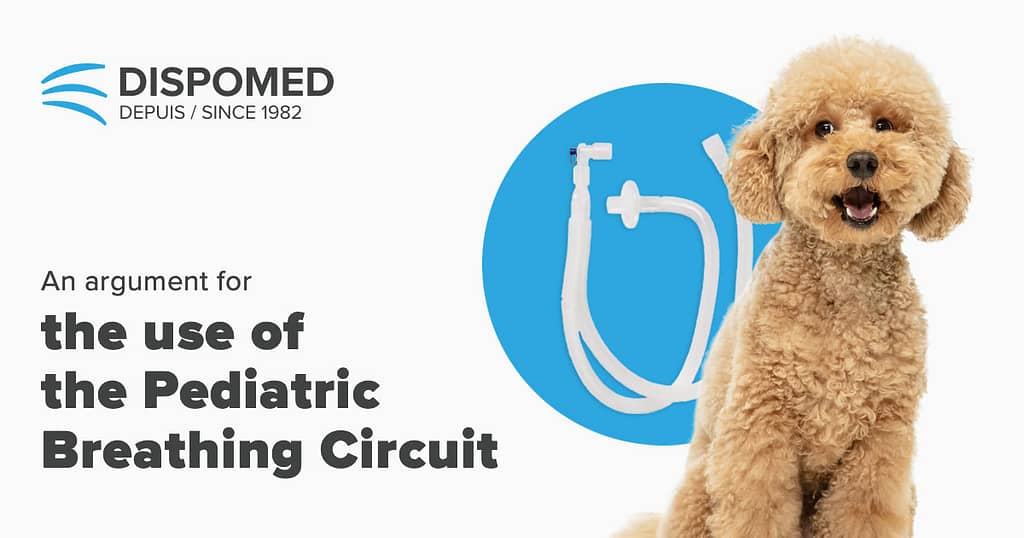I have been a huge fan of pediatric circle breathing circuits for small patients for about 15 years. They save me money, they help retain patient heat and moisture and they have improved my monitoring of small anesthetized patients.
Money is saved because the circle requires lower oxygen flow. This results in less frequent refilling of the vaporizer and oxygen tanks.
Heat and moisture are retained because the warm and moist gas from the patient’s lungs is exhaled, mixes with the cooler, dry incoming fresh gas and is then re-inhaled minus the carbon dioxide.
Monitoring is enhanced because the capnograph gives a true representation of exhaled and inhaled carbon dioxide levels over the course of each breath. The improved reliability of the capnograph allows for early detection of anesthesia equipment malfunction as well as assessment the patient’s anesthetic depth.
When I attended veterinary school, I was taught that all patients above 10 kg were to receive inhalant anesthesia via an adult circle breathing system. Patients below this weight were connected to non-circle breathing circuits such as the Bain, Jackson-Rees or Ayre’s T piece. Compared to the adult circle system, the non-circle systems offer the least amount of dead space and require the least amount of effort by the anesthetized patient to move gases through the circle. Fortunately, with new understanding about what is involved in the effort to breathe while under inhalant anesthesia along with the introduction of the pediatric circle, dead space and breathing effort have ceased to be issues in patients above 2 kg.
As suggested by the term “non-circle”, the Bain, Jackson-Rees and Ayre’s T circuits are not connected to any sort of carbon dioxide absorber granule canister. To compensate for this absence, a high oxygen flow rate is required throughout the entire anesthetic periodic order to flush the patient’s exhaled carbon dioxide out through the scavenger system so that it does not accumulate in the breathing hoses. Carbon dioxide in the inhaled gas can be problematic if the levels get high.
The capnograph’s inaccuracy when used with non-circle breathing systems is an important consideration for anesthesia depth assessment and trouble shooting (both patient and anesthesia machine). It is the main reason why I switched over to pediatric breathing circuits about 15 years ago, for all patients between 2 kg and 10 to 15 kg. So, first came my introduction of the capnograph to my anesthesia monitoring toolbox. Then came my adoption of the pediatric circle for my small patients so that I could make best use of this beloved monitoring tool.
Why does the choice of breathing circuit make such a difference to capnography?
With the non-circle circuits, the absence of the circle’s valves allows the carbon dioxide-free incoming fresh gases to mix with the high carbon dioxide exhaled gases. This mixing dilutes the amount of carbon dioxide in the gas sample that is presented to the capnograph for measurement. Thus, the information being conveyed by the capnograph is erroneous, unreliable and non-diagnostic.
Anyone who has experienced difficulty in evaluating anesthetic depth of patients under the influence of medetomidine or dexmedetomidine premedication will appreciate the value of the capnograph in assisting with this assessment: in the presence of hypertension, bradycardia, an absent palpebral reflex and almost non-existent jaw tone, the anesthetist can confidently use the end tidal carbon dioxide values to determine if the plane of anesthesia is light, deep or somewhere in between.
- Reduced heat and moisture loss
- More reliable information from the capnograph monitor
- Ease of function/leak testing compared to the Bain circuit
In all small patients above 2 kg up to about 10-15 kg (depending on endotracheal tube size), as a tool to blunt the severity of hypothermia and help with improved assessment of anesthetic depth.
Patients under 2 kg will need non-circle circuits as otherwise they will struggle to move gas through the breathing hoses, the absorber canister and circle’s valves. Patients in this size group include pocket pets, birds, reptiles and juvenile cats and dogs.
I can’t really think of medical conditions that would dictate one circuit as having advantages over another unless the clinician wants extra breathing circuit hose length in order to distance the patient from the anesthetic machine as in head and neck procedures. The Bain circuit provides the extra
length without increasing the overall internal volume of the breathing circuit compared to the pediatric circle. The larger the internal volume of the breathing circuit the more difficult it is for the anesthetist to rapidly deepen or lighten the plane of anesthesia.
Of the three non-circle circuits mentioned above, Bain circuits are my preferred breathing systems as they can be attached to commercially available Bain brackets with built-in pressure gauges and exhaust outlets that facilitate scavenging excess gas and manual ventilation if it is needed. I believe that all circuits, circle and non-circle should be connected to pressure gauges and alarms to prevent accidental barotrauma.






